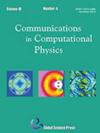基于可压缩湍流涡流识别的高阶自适应耗散方案
IF 3.1
3区 物理与天体物理
Q1 PHYSICS, MATHEMATICAL
引用次数: 0
摘要
在涉及冲击波的可压缩湍流数值模拟中,准确捕捉错综复杂的涡旋结构和稳健计算冲击波势在必行。事实证明,采用具有自适应耗散特性的高阶方案是一种既能精确区分小尺度涡旋结构,又能捕捉不连续性的有效方法。然而,在计算过程中区分小尺度涡旋结构和不连续性一直是一个关键挑战。本文介绍了一种基于漩涡识别的高阶自适应耗散中央上风加权紧凑非线性方案(命名为WCNS-CU-Ω),它能够通过识别流场中的漩涡来物理区分高波数区域的冲击波和小尺度漩涡结构,从而实现插值方案数值耗散的自适应控制。为了验证 WCNS-CU-Ω 方案的性能,对涉及欧拉、N-S 甚至 RANS 方程的各种情况进行了测试。结果发现,这种新方案在捕捉冲击波方面具有出色的小尺度分辨率和鲁棒性。因此,它可以更广泛地应用于可压缩湍流的数值模拟。本文章由计算机程序翻译,如有差异,请以英文原文为准。
High-Order Adaptive Dissipation Scheme Based on Vortex Recognition for Compressible Turbulence Flow
In the numerical simulation of compressible turbulence involving shock
waves, accurately capturing the intricate vortex structures and robustly computing
the shock wave are imperative. Employing a high-order scheme with adaptive dissipation characteristics proves to be an efficient approach in distinguishing small-scale
vortex structures with precision while capturing discontinuities. However, differentiating between small-scale vortex structures and discontinuities during calculations has
been a key challenge. This paper introduces a high-order adaptive dissipation central-upwind weighted compact nonlinear scheme based on vortex recognition (named as
WCNS-CU-Ω), that is capable of physically distinguishing shock waves and small-scale vortex structures in the high wave number region by identifying vortices within
the flow field, thereby enabling adaptive control of numerical dissipation for interpolation schemes. A variety of cases involving Euler, N-S even RANS equations are tested
to verify the performance of the WCNS-CU-Ω scheme. It was found that this new
scheme exhibits excellent small-scale resolution and robustness in capturing shock
waves. As a result, it can be applied more broadly to numerical simulations of compressible turbulence.
求助全文
通过发布文献求助,成功后即可免费获取论文全文。
去求助
来源期刊

Communications in Computational Physics
物理-物理:数学物理
CiteScore
4.70
自引率
5.40%
发文量
84
审稿时长
9 months
期刊介绍:
Communications in Computational Physics (CiCP) publishes original research and survey papers of high scientific value in computational modeling of physical problems. Results in multi-physics and multi-scale innovative computational methods and modeling in all physical sciences will be featured.
 求助内容:
求助内容: 应助结果提醒方式:
应助结果提醒方式:


